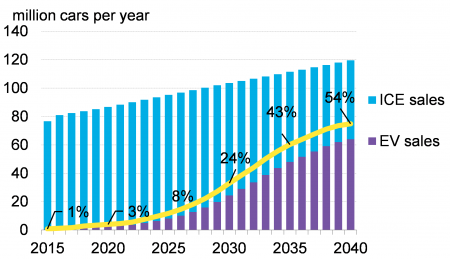July 7, 2017 – Yesterday a report published by Bloomberg reflected what is becoming more apparent each day. The electric vehicle (EV) is the future of the automobile industry. But before I talk about what the report states it is important to note that this week Volvo, the Swedish-based car manufacturer announced its entire model offerings in 2019 will be either hybrid or electric. The plan is to introduce 5 all EV models between 2019 and 2021. These will be 100% electric powered. The balance of the product line will include gasoline and diesel plug-in hybrid, and standalone hybrid models. No Volvo vehicles sold will be without an electric motor.
Volvo isn’t Tesla. It’s not a newcomer to the automobile industry. As a result embracing the EV over gasoline and diesel-powered vehicles points to the direction all automobile companies will go. EVs are going mainstream faster than most anticipated. The infrastructure gap (charging stations) notwithstanding, is no longer an inhibitor to the transition. Range anxiety is also going away as new models from Tesla and General Motors push the limits these vehicles can go beyond the average daily commute.
Volvo notes that consumers are very much driving the changeover because of carbon, climate change, and global warming concerns. States Hakan Samuelsson, President and Chief Executive at Volvo, “This is about the customer….People increasingly demand electrified cars and we want to respond to our customers’ current and future needs.” He goes on to state, “This announcement marks the end of the solely combustion engine-powered car.” Volvo sold 534,332 cars in 2016. The company forecasts annual sales of 1 million of its new electrified models by 2025. The timing of the Volvo move to EVs, many years ahead of what industry pundits previously forecasted indicates that at least in this case, a manufacturer is moving faster to make the transition to non-fossil-fuel-powered vehicles.
Now back to the Bloomberg New Energy Finance (BNEF) forecast. Put together by the advanced transport team, it analyzes the cost and performance trends impacting batteries as well as other factors and concludes that EVs will represent more than half of all new light vehicle sales by 2040. States Colin McKerracher, lead analyst at BNEF, “We see a momentous inflection point for the global auto industry in the second half of the 2020s. Consumers will find that upfront selling prices for EVs are comparable or lower than those for average ICE vehicles in almost all big markets by 2029.” The term ICE refers to internal combustion engines.
EV sales are growing steadily. In 2016, consumers purchased 700,000. That number is expected to reach 3 million by 2021. For Europe that represents 5% of all new light-vehicle sales; for the United States and China, 4%. But it is from the mid-2020s that BNEF sees EVs taking off because they will be cheaper to own and operate than ICE-powered vehicles.

Today lithium-ion batteries represent the standard in powering EVs. There are other battery technologies out there. For example, my new Toyota RAV4 Hybrid uses nickel-metal-hydride batteries. Toyota has made nickel-metal-hydride its standard since its first Prius hybrids were introduced. Lithium-ion produces more energy per kilogram than nickel-metal-hydride, but the material’s potential volatility has always been a concern. Consider how lithium-ion battery packs on some cell phone models caught fire in the last couple of years. At some point in the near future, current batteries will be replaced by lighter and safer technologies; for example, batteries that draw on ambient air rather than onboard oxidizers, or that use material less volatile than lithium to store electricity.
I encourage you to read about aluminum-air, sodium-air, potassium ion, and lithium-sulfur batteries, just a few of the new technologies I have discovered in my own research. Any of these or all could become alternatives to the current lithium-ion standard, accelerating the EV growth curve.
BNEF analysts see battery price and performance as the game changer. Even in the face of low diesel and gasoline prices, EVs will represent 67% of new car sales in Europe by 2040 with Norway, France, and the United Kingdom the biggest markets. Comparably 58% of new car sales in the United States and 51% in China will be EVs. Economics and not the environment will be the prime driver, although the latter will remain an important aspect of consumer decision making.
We won’t be rid of ICE-powered vehicles despite the growth in sales of EVs. BNEF forecasts that ICE will continue to dominate with legacy product representing 67% of all vehicles on the road in 2040.
The BNEF forecast also looked at autonomous vehicles and ride sharing. The analysts concluded that the former will remain limited for at least the next decade. But by 2030 autonomous vehicles will begin to prevail in tandem with the rise in sales of low-cost, low-maintenance EVs.








